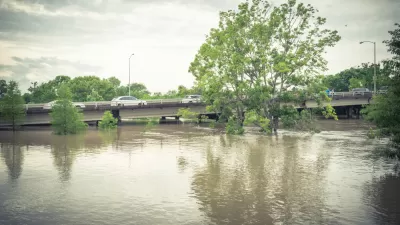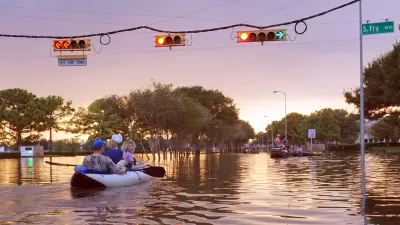Hurricane Harvey was expected to make landfall late Friday or early Saturday. If the damage in human and economic terms is terrible, a lack of infrastructure maintenance and development responsibility will be to blame.
Jessica Leigh Hester reports on the impending threat of Hurricane Harvey, which as of this writing had yet to make landfall on the Texas Coast.
The article presents the threats presented by Hurricane Harvey as particularly dire. Here's one of the summarizing passages describing the confluence of planning and development decisions that could make Harvey a much more dangerous visitor than previous storms.
As the population has boomed across this Sunbelt city in recent years, an increasing number of people and buildings find themselves in a vulnerable position. Meanwhile, thousands of acres of wetlands that might have helped absorb excess rainfall have been gobbled up by development. When paved surfaces can’t perform the crucial work of stormwater retention, “even lesser storms are invested with more destructive power,” Kriston Capps noted last summer. Harvey is no minor storm—and it is slated to batter a city with relatively poor flood infrastructure and no statewide insurance requirement.
Hester also sits down for an interview with Samuel David Brody, director of the Center for Texas Beaches and Shores at Texas A&M Galveston, to get more insight on what to expect from the storm.
FULL STORY: 'This Storm Has It All'

Maui's Vacation Rental Debate Turns Ugly
Verbal attacks, misinformation campaigns and fistfights plague a high-stakes debate to convert thousands of vacation rentals into long-term housing.

Planetizen Federal Action Tracker
A weekly monitor of how Trump’s orders and actions are impacting planners and planning in America.

San Francisco Suspends Traffic Calming Amidst Record Deaths
Citing “a challenging fiscal landscape,” the city will cease the program on the heels of 42 traffic deaths, including 24 pedestrians.

Defunct Pittsburgh Power Plant to Become Residential Tower
A decommissioned steam heat plant will be redeveloped into almost 100 affordable housing units.

Trump Prompts Restructuring of Transportation Research Board in “Unprecedented Overreach”
The TRB has eliminated more than half of its committees including those focused on climate, equity, and cities.

Amtrak Rolls Out New Orleans to Alabama “Mardi Gras” Train
The new service will operate morning and evening departures between Mobile and New Orleans.
Urban Design for Planners 1: Software Tools
This six-course series explores essential urban design concepts using open source software and equips planners with the tools they need to participate fully in the urban design process.
Planning for Universal Design
Learn the tools for implementing Universal Design in planning regulations.
Heyer Gruel & Associates PA
JM Goldson LLC
Custer County Colorado
City of Camden Redevelopment Agency
City of Astoria
Transportation Research & Education Center (TREC) at Portland State University
Jefferson Parish Government
Camden Redevelopment Agency
City of Claremont




























